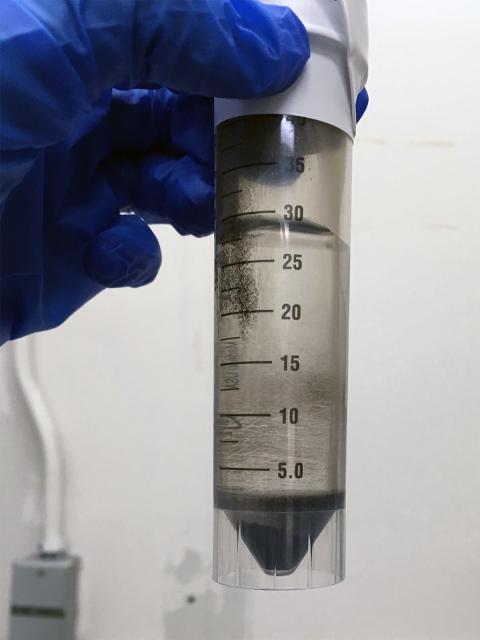Millions of medical imaging procedures each year rely on radioactive technetium. One of its radioisotopes decays quickly and is useful as a tracer material in nuclear medicine. But another, technetium-99, is very long-lived, poses a risk to the environment, and is a potential health threat.
Technetium can be found in nuclear reactor waste and at sites that processed uranium for nuclear weapons during the Cold War, such as the Hanford Site in Washington State. The most prevalent form of technetium-called pertechnetate-is water soluble and has a high potential for spreading through the soil and groundwater.
But now, researchers at Pacific Northwest National Laboratory (PNNL), Florida International University, and the Illinois Institute of Technology are closer to understanding how high concentrations of technetium-99 can be treated by simple iron, which is inexpensive and readily available.
The team recently completed experiments in which almost all-99.8%-of the technetium was removed from a liquid solution after one month in contact with iron particles. This occurs as the iron oxidizes or loses electrons in a chemical process called reductive removal.
"We just let them sit in contact with each other," said Daria Boglaienko, an environmental scientist at PNNL. "That's what's different about this study. We did not control any parameters such as acidity or temperature or oxygen content. We just let the reaction unfold spontaneously, as it would in nature if these two compounds came in contact with each other."
The team went on to analyze the reaction products at the atomic scale with sophisticated instruments at PNNL's Radiochemical Processing Laboratory and two U.S. Department of Energy (DOE) Office of Science user facilities-EMSL, the Environmental Molecular Sciences Laboratory at PNNL, and the Advanced Photon Source, located at Argonne National Laboratory.
Previous studies observed this reaction under controlled anaerobic conditions and/or with relatively low loadings of technetium. But this study is the first to show how the reaction occurs spontaneously under aerobic conditions with high concentrations of technetium, and to understand how the technetium is incorporated into the iron mineral lattice.
Researchers revealed in the Nature Research journal Communications Chemistry that clusters of technetium partially incorporate into iron minerals, such as magnetite, during simultaneous iron oxidation and mineralization. This is the same incorporation mechanism that would be expected in a natural system.
Cleanup potential

"The fact that this experiment was conducted in conditions that would spontaneously occur with the introduction of iron, known as zero valent iron, has positive implications for environmental cleanup efforts in the subsurface or nuclear waste treatment systems," said corresponding author Tatiana Levitskaia, a chemist at PNNL.
Researchers also found that the presence of technetium slows the oxidation of the metallic iron and its ultimate transformation from ferrihydrite to magnetite. The slower process gives the technetium time to incorporate into the magnetite.
Once lodged within the crystalline structure, the technetium does not re-oxidize back to its more mobile form of pertechnetate-it is instead sequestered for the long term, which minimizes the risk of release back into the groundwater or subsurface environment.
The research team continues to work with zero valent iron. They have tested its ability to separate and sequester technetium at Hanford, where cleanup will involve vitrification-or turning liquid wastes into glass-for safe long-term storage. A portion of the technetium may not fully incorporate into the glass and end up in a secondary waste stream. Zero valent iron may be effective in removing technetium from these secondary wastes.
The research was supported by DOE's Office of Environmental Management and its Minority Serving Institution Partnership Program. It was performed as part of DOE's Technetium Management Project.
The article, "Spontaneous redox continuum reveals sequestered technetium clusters and retarded mineral transformation of iron," published in the July 2020 edition of Communications Chemistry, DOI: 10.1038/s42004-020-0334-x.
In addition to Boglaienko and Levitskaia, the authors included the PNNL research team of Jennifer Soltis, Ravi Kukkadapu, Yingee Du, Lucas Sweet, Vanessa Holfeltz, Gabriel Hall, Edgar Buck, and Hilary Emerson; with Carlo Segre at the Illinois Institute of Technology and Yelena Katsenovich at Florida International University.






